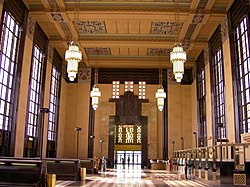Omaha Union Station
 From Wikipedia - Reading time: 11 min
From Wikipedia - Reading time: 11 min
Union Passenger Terminal | |
 Interior of Union Station | |
 Interactive map showing the location for Omaha Union Station | |
| Location | 801 South 10th Street Omaha, Nebraska |
|---|---|
| Coordinates | 41°15′5.5″N 95°55′41.8″W / 41.251528°N 95.928278°W |
| Built | 1931 |
| Architect | Gilbert Stanley Underwood |
| Architectural style | Art Deco |
| Part of | Omaha Rail and Commerce Historic District (ID96000769) |
| NRHP reference No. | 71000484 |
| Significant dates | |
| Added to NRHP | November 12, 1971 |
| Designated NHL | December 23, 2016 |
| Designated CP | July 19, 1996 |
The Union Station, at 801 South 10th Street in Omaha, Nebraska, known also as Union Passenger Terminal, is "one of the finest examples of Art Deco architecture in the Midwest".[1] Designated an Omaha Landmark in 1978, it was listed as "Union Passenger Terminal" on the National Register of Historic Places in 1971,[2] and was designated a National Historic Landmark in 2016.[3] The Union Station is also a contributing property to the Omaha Rail and Commerce Historic District. It was the Union Pacific's first Art Deco railroad station,[4][5][6] and the completion of the terminal "firmly established Omaha as an important railroad terminus in the Midwest".[7]
History
[edit]The second depot was designed by Chicago architect Charles Sumner Frost, and construction began in October, 1898. Completed on December 1, 1899 at a cost of $405,782, the building's façade rose 60 feet (18 m) above the Tenth Street Viaduct the building faced. It was primarily built from pressed brick made in Omaha, as well as Bedford stone used in the architectural details. A canopy of glass and iron protected passengers from the elements as they entered the station.
Current structure
[edit]We have tried to express the distinctive character of the railroad: strength, power, masculinity.
— Omaha Union Station Architect Gilbert Stanley Underwood[8]

Designed by Gilbert Stanley Underwood of Los Angeles, the current building features a steel frame structure that is clad with cream-colored glazed terra cotta.[1] Groundbreaking occurred on July 29, 1929, and the building was completed on January 15, 1931. The 124,000-square-foot (11,500 m2) cost $3.5 million to build.[5] Of the building's design, Underwood was said to have remarked, "We have tried to express the distinctive character of the railroad: strength, power, masculinity."[8] At its dedication, Carl R. Gray, president of the Union Pacific, declared the station to be, "Dedicated by the railways of Omaha to serve, comfort and convenience of the people."[5]
The construction of the station was preceded by the construction of the Burlington Train Station one block away. Within ten years that station was served by seven railroads.[9] Upon its completion, the Union Station became renowned for its technological innovations, including electric luggage conveyor belts, escalators and extensive lighting throughout the building. Simultaneously, patrons and critics alike appreciated the traditional and lavish attributes of the building, including massive women's restrooms, beautiful marble columns and flooring throughout, and deep oak woodwork surrounding every window and door in the station.[10] During its first year, 1.5 million passengers passed through.[5]

By 1946, 64 steam locomotives were in operation bringing 10,000 passengers daily in and out of the Union Station.[11] However, within a decade everything changed. In 1956 the Chicago and North Western Railroad stopped its line running through Omaha. 1960 saw the exit of Wabash Railroad. In 1965 the Missouri Pacific Railroad and the Chicago Great Western Railway quit running, followed by the Rock Island Railroad in 1969. Passenger service ceased in 1971, and the Union Station was donated to the City of Omaha by the Union Pacific Railroad in 1973.[12]
That year the station quickly became the home of the Durham Museum. The Union Pacific Museum and Archives were also located there. In 1997 the Union Station underwent a renovation that included a 22,000-square-foot (2,000 m2) addition and new climate controls for the museum,[11] and today the building is a contributing property to the Omaha Rail and Commerce Historic District, bordering the Old Market Historic District and Omaha's Little Italy.
See also
[edit]Bibliography
[edit]- (1973) Historical Architecture of Omaha by Henry W. Wong.
- (2001) Union Pacific and Omaha Union Station by Carla Johnson.
- (1999) Omaha railroad Stations by John Peterson.
References
[edit]- ^ a b (nd) "Union Station". Archived September 25, 2007, at the Wayback Machine City of Omaha Landmarks Heritage Preservation Commission. Retrieved 7/8/07.
- ^ (nd) National Register of Historic Places - Douglas County, Nebraska. Retrieved 7/8/07.
- ^ National Park Service (March 3, 2017), Weekly List of Actions Taken on Properties: 2/16/2017 through 3/2/2017, archived from the original on March 7, 2017, retrieved March 7, 2017.
- ^ Johnson, C. (2001) Union Pacific and Omaha Union Station:A History of Union Pacific Railroad Passenger Station in Omaha, Nebraska 1866-1971. South Platte Press. pp. 24. Retrieved 7/8/07.
- ^ a b c d Durham Western Heritage Museum. (nd) Museum Exterior Architecture. Archived September 28, 2007, at the Wayback Machine Retrieved 7/14/07.
- ^ Beman, A. (nd) "I Get a Kick Outta Train Number 6: New Friends and Fuzzy Slippers on the California Zephyr," Amtrak. Retrieved 7/14/07.
- ^ (2007) "More Nebraska National Register Sites in Douglas County,"[usurped] Nebraska State Historical Society. Retrieved 7/15/07.
- ^ a b Potter, J. G. (1996) Great American Railroad Stations. John Wiley and Sons. p. 377.
- ^ Johnson, C. Union Pacific and the Omaha Union Station. South Platte Press. Retrieved 7/8/07.
- ^ (1939) Railroad Age. Simmons-Boardman. p. 134.
- ^ a b Cook, H. (1997) "Renovation keeps museum on track," Building Design and Construction. April.
- ^ Holland, Kevin J. (2001). Classic American Railroad Terminals. Osceola, WI: MBI. p. 122. ISBN 9780760308325. OCLC 45908903.
 KSF
KSF